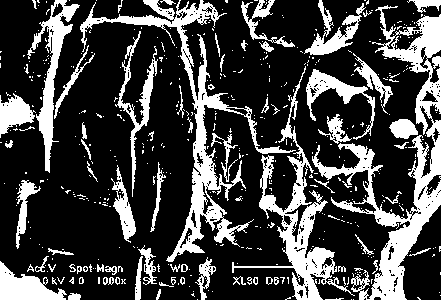Preparation method and application of water treatment material based on typha orientalis presl
A technology for water treatment and papyrus, which is applied in water/sewage treatment, adsorbed water/sewage treatment, water/sludge/sewage treatment, etc. It can solve problems such as lack of economic value and achieve the effect of strong adsorption capacity.
- Summary
- Abstract
- Description
- Claims
- Application Information
AI Technical Summary
Problems solved by technology
Method used
Image
Examples
Embodiment 1
[0018] Harvest the naturally growing cattail grass, wash it with tap water, dry it, put the cleaned cattail grass in a grinder, and grind it into particles with a particle size of 40-80 mesh, and place the pulverized cattail grass particles at a mass concentration of 0.1%. 3-aminopropyltrimethoxysilane methanol solution for 4 hours, take it out, put it in an oven, and bake it at 120°C for 4 hours, take it out, wash it with deionized water, and dry it to get chemically modified papyrus water Handle material.
[0019] Put 0.03g of the modified cattail grass material in 20ml of lead-containing wastewater, adjust the pH value of the solution to 5.3, and absorb it at 20°C for 4 hours. The concentration of lead ions in the lead wastewater is 1000mg / L. After the adsorption is completed, filter and pass the test. According to the amount of residual lead ions in the solution, the lead ion adsorption capacity of the cattail grass material is 295.1 mg / g, that is, 295.1 mg of lead ion can...
Embodiment 2
[0022] Harvest the naturally growing cattail grass, wash it with tap water, dry it, put the cleaned cattail grass in a grinder, and grind it into particles with a particle size of 40-80 meshes, and place the pulverized cattail grass particles at a mass concentration of 5% citric acid ethanol solution for 1 hour, take it out, put it in an oven, and bake it at 100°C for 12 hours, take it out, wash it with deionized water, and dry it to obtain a chemically modified cattail grass-based water treatment material.
[0023] Put 0.03g of the modified cattail grass material in 20ml of lead-containing wastewater, adjust the pH value of the solution to 5.6, and absorb it at 20°C for 4 hours. The concentration of lead ions in the lead wastewater is 500mg / L. After the adsorption is completed, filter and pass the test. According to the amount of residual lead ions in the solution, the lead ion adsorption capacity of the cattail grass material is 352.2 mg / g, that is, 352.2 mg of lead ion can b...
Embodiment 3
[0026] Harvest the naturally growing cattail grass, wash it with tap water, dry it, put the cleaned cattail grass in a grinder, and crush it into particles with a particle size of 40-80 meshes, and place the pulverized cattail grass particles at a mass concentration of 3% tartaric acid isopropanol solution for 2 hours, took it out, placed it in an oven, baked it at 120°C for 8 hours, took it out, washed it with deionized water, and dried it to obtain a chemically modified catkin-based water treatment material.
[0027] Put 0.03g of the modified cattail grass material in 20ml of lead-containing waste water, adjust the pH of the solution to 5.0, and absorb it at 20°C for 4 hours. The concentration of lead ions in the lead waste water is 2000 mg / L. After the adsorption is completed, filter and pass the test According to the amount of residual lead ions in the solution, the lead ion adsorption capacity of the cattail grass material is 336.2 mg / g, that is, 336.2 mg of lead ion can b...
PUM
| Property | Measurement | Unit |
|---|---|---|
| Particle size | aaaaa | aaaaa |
| Adsorption capacity | aaaaa | aaaaa |
| Adsorption capacity | aaaaa | aaaaa |
Abstract
Description
Claims
Application Information
 Login to View More
Login to View More - R&D
- Intellectual Property
- Life Sciences
- Materials
- Tech Scout
- Unparalleled Data Quality
- Higher Quality Content
- 60% Fewer Hallucinations
Browse by: Latest US Patents, China's latest patents, Technical Efficacy Thesaurus, Application Domain, Technology Topic, Popular Technical Reports.
© 2025 PatSnap. All rights reserved.Legal|Privacy policy|Modern Slavery Act Transparency Statement|Sitemap|About US| Contact US: help@patsnap.com

